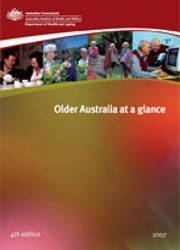Summary
This 4th edition of Older Australia at a glance describes the characteristics and circumstances of Australia’s 2.7
million older Australians using key statistics in relation to 45 topics or areas of interest. This edition differs from previous ones (AIHW 1997; AIHW: Gibson et al. 1999; AIHW 2002b) in several ways. Firstly, this version looks to future generations of older people, by including information on those now aged 50 to 64 years, providing potential insights into how future cohorts of older people may be similar or different from current cohorts.
Secondly, this edition reflects the more sophisticated approaches which are increasingly evident in both policy and research directed at understanding personal and population ageing, by incorporating a broader range of topics on transport use; use of technology; intergenerational transfers within families; vision problems; oral health; dental services; and Extended Aged Care at Home. In keeping with this more comprehensive approach, other pre-existing topics have been expanded to include new material on social and community participation; superannuation; wealth and expenditure; and each of the National Health Priority Areas.
Preliminary material (226KB PDF): Foreword; Contributors; Acknowledgments; Abbreviations and symbols; Overview
Demographic profile (334KB PDF)
- Age, sex and cultural diversity
- The changing demographic profile
Social and economic context (518KB PDF)
- Marital status and living arrangements
- Housing
- Transport
- Workforce participation
- Retiring from paid work
- Community and civic participation
- Providing care
- Social participation and leisure
- Use of technology
- Income, wealth and expenditure
- Age Pension and superannuation
- Intergenerational transfers within families
Health and functioning (513KB PDF)
- Ageing and health risk factors
- Life expectancy, health status and causes of death
- Disability
- Burden of disease
- Cardiovascular disease
- Cancer
- Diabetes mellitus
- Respiratory disease
- Mental health
- Osteoarthritis and other musculoskeletal conditions
- Dementia
- Vision problems
- Oral health
Use of health and aged care services (502KB PDF)
- The Australian health and welfare systems
- Care needs and sources of care
- General practitioner services
- Use of pharmaceuticals
- Dental services
- Hospital use
- Reasons for admission to hospital
- Aged care assessment
- Home and Community Care Program
- Community Aged Care Packages
- Extended Aged Care at Home and Extended Aged Care at Home Dementia packages
- Respite care
- Residential aged care: resident profiles
- Residential aged care: patterns of supply and use
Special population groups (385KB PDF)
- Older Aboriginal and Torres Strait Islander peoples
- People from non-English-speaking countries
- Older people in regional and remote communities
- Older veterans
End matter (528KB PDF): Appendix tables; References; List of tables; List of figures



